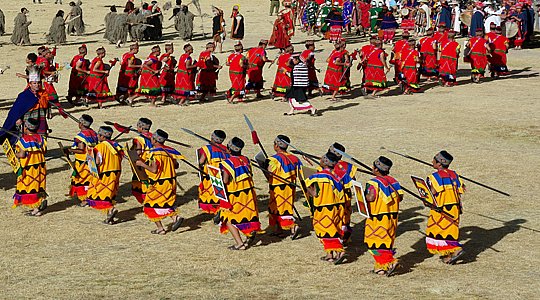Festival of Sun
The Inti Raymi (“festival of the Sun”) was the religious ceremony of the Inca Empire in the honour of the God Inti, one of the most venerated deities in the Inca religion. It was the celebration of the Winter Solstice- the shortest day of the year in the terms of the time between the sunrise and Sunset and the Inca New year. In the territories south of the equator the Gregorian months of the June and July are the winter months.
During the Inca Empire, the Inti Raymi was the most important of four ceremonies celebrated in the Cusco, as related by the Inca Garcilaso de la Vega. The celebration took place at the Haukaypata or the main plaza in the city.
Before the colonial Spaniards banned the ceremonial events occurring each winter Solstice in Cuzco, the native residents gathered to honour the Sun God, sacrifice an animal to ensure the good crops and to pay homage to the Inca, as the first Son of the Sun.
The ceremonies took place at the winter solstice, when sun is farthest from the earth. Fearing the lack of sun and ensuing famine, the ancient Incas gathered in the Cuzco to honour the Sun God and plead for his return.
According to the chronicler Garcilaso de la vega, Sapa Inca Pachacuti created the Inti Raymi to celebrate the new year in the Andes of the Southern Hemisphere. The ceremony also said to indicate the mythical origin of the Incas. The festival lasted for nine days and was filled with the colourful dances and processions, as well as animal sacrifices to thank the Pachamama and to ensure the good cropping season. The first Inti Raymi was in 1412. The last Inti Raymi with the Inca Emperor’s presence was carried out in 1535 after which the Spanish and the Catholic priest banned it.
Inti Raymi is still celebrated in indigenous culture throughout the Andes. Celebration involves the music, colourful costumes and the sharing of food. In many parts of the Andes though, this celebration has been connected to the western festivals of Saint John the Baptist, which falls on the day after the northern solstice.
During the Inca Empire, the Inti Raymi was the most important of four ceremonies celebrated in the Cusco, as related by the Inca Garcilaso de la Vega. The celebration took place at the Haukaypata or the main plaza in the city.
Before the colonial Spaniards banned the ceremonial events occurring each winter Solstice in Cuzco, the native residents gathered to honour the Sun God, sacrifice an animal to ensure the good crops and to pay homage to the Inca, as the first Son of the Sun.
The ceremonies took place at the winter solstice, when sun is farthest from the earth. Fearing the lack of sun and ensuing famine, the ancient Incas gathered in the Cuzco to honour the Sun God and plead for his return.
According to the chronicler Garcilaso de la vega, Sapa Inca Pachacuti created the Inti Raymi to celebrate the new year in the Andes of the Southern Hemisphere. The ceremony also said to indicate the mythical origin of the Incas. The festival lasted for nine days and was filled with the colourful dances and processions, as well as animal sacrifices to thank the Pachamama and to ensure the good cropping season. The first Inti Raymi was in 1412. The last Inti Raymi with the Inca Emperor’s presence was carried out in 1535 after which the Spanish and the Catholic priest banned it.
Inti Raymi is still celebrated in indigenous culture throughout the Andes. Celebration involves the music, colourful costumes and the sharing of food. In many parts of the Andes though, this celebration has been connected to the western festivals of Saint John the Baptist, which falls on the day after the northern solstice.
.png)




0 comments: